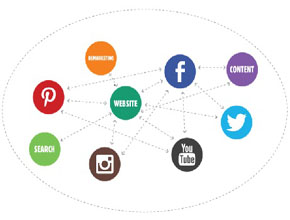Our Other Solutions
Information Technology & Infrastructure Solutions:
The company leads with expertise in delivering infrastructure solutions. By offering world class solutions that leverage the power of collaboration, people, ideas and relationships. Partnering with very large technology companies globally, Sapphire meets the requirements of various verticals in India.
Sapphire helps startups to setup their IT infrastructure to leverage their present solutions. By offering planning, designing and deployment services helps customer to achieve simplified operations, improved ROI, Increased utilization and optimized performance of existing infrastructure. Consulting team and talented staff work closely with the customer to understand their business requirements and align their business processes with IT to achieve optimum efficiency from deployed IT infrastructure. This helps customer to align their people, process and technology to contribute to an agile enterprise environment. Sapphire offers strategic and solutions to variety of verticals in present competitive environment.
Sapphire offers solutions in following areas :
- Enterprise Computing
- Information Security
- Messaging and collaboration
- Enterprise Management
- Convergence
- Thin Client computing
- Telecom Solutions
- Infrastructure Solutions
- Server Hardware and Desktops
Network Management :
TIA/EIA Structured Cabling Standards
In the mid-1980s, the TIA (Telecommunications Industry Association) and the EIA (Electronic Industries Association) began developing methods for cabling buildings, with the intent of developing a uniform wiring system that would support multivendor products and environments. In 1991, the TIA/EIA released the TIA/EIA 568 Commercial Building Telecommunication Cabling standard. Note that the ISO/IEC-11801 Generic Customer Premises Cabling standard is an international cabling standard that is based on the ANSI/TIA/EIA-568 cabling standard.
The TIA/EIA structured cabling standards define how to design, build, and manage a cabling system that is structured, meaning that the system is designed in blocks that have very specific performance characteristics. The blocks are integrated in a hierarchical manner to create a unified communication system. For example, workgroup LANs represent a block with lower-performance requirements than the backbone network block, which requires high-performance fiber-optic cable in most cases. The standard defines the use of fiber-optic cable (single and multimode), STP (shielded twisted pair) cable, and UTP (unshielded twisted pair) cable. The initial TIA/EIA 568 document was followed by several updates and addendums as outlined below. A major standard update was released in 2000 that incorporates previous changes.
-
TIA/EIA-568-A-1995 (Commercial Building Telecommunications Wiring Standards) Defines a standard for building cable system for commercial buildings that support data networks, voice, and video. It also defines the technical and performance criteria for cabling.
-
TIA/EIA-568-A updates (1998-1999) The TIA/EIA-568 was updated several times through this time period. Update A1 outlined propagation delay and delay skew parameters. Update A2 specified miscellaneous changes. Update A3 specified requirements for bundled and hybrid cables. Update A4 defined NEXT and return loss requirements for patch cables. Finally, update A5 defined performance requirements for Enhanced Category 5 (Category 5E).
-
TIA 568-B.1-2000 (Commercial Building Telecommunications Wiring Standard) The year 2000 update packages all the previous addendums and service updates into a new release and, most important, specifies that Category 5E cable is the preferred cable type that can provide minimum acceptable performance levels. Several addendums were also released that specify technical information for 100-ohm twisted-pair cable, shielded twisted-pair cable, and optical fiber cable.
-
TIA/EIA-569-A-1995 (Commercial Building Standard for Telecommunications Pathways and Spaces) This standard defines how to build the pathways and spaces for telecommunication media.
-
TIA 570-A-1998 (Residential and Light Commercial Telecommunications Wiring Standard) This standard specifies residential cabling.
-
TIA/EIA-606-1994 (Building Infrastructure Administration Standard) This standard defines the design guidelines for managing a telecommunications infrastructure.
- TIA/EIA-607-1995 (Grounding and Bonding Requirements) This standard defines grounding and bonding requirements for telecommunications cabling and equipment.
The current trend is to evolve the standards to support high-speed networking such as Gigabit Ethernet and define advanced cable types and connectors such as four-pair Category 6 and Category 7 cable. Category 6 is rated for channel performance up to 200 MHz, while Category 7 is rated up to 600 MHz. See "Cable and Wiring" for more information about cable types.
The remainder of this section discusses the TIA/EIA-568 standard in general, rather than any specific release. According to TIA/EIA 568 documents, the wiring standard is designed to provide the following features and functions:
-
A generic telecommunication wiring system for commercial buildings
-
Defined media, topology, termination and connection points, and administration
-
Support for multiproduct, multivendor environments
-
Direction for future design of telecommunication products for commercial enterprises
- The ability to plan and install the telecommunication wiring for a commercial building without any prior knowledge of the products that will use the wiring
The layout of a TIA/EIA 568-A structured cable system is illustrated in Figure T-8. The hierarchical structure is apparent in the multifloor office building. A vertical backbone cable runs from the central hub/switch in the main equipment room to a hub/switch in the telecommunication closet on each floor. Work areas are then individually cabled to the equipment in the telecommunication closet. The logical hierarchy is illustrated in Figure T-9.
The TIA standard defines the parameters for each part of the cabling system, which includes work area wiring, horizontal wiring, telecommunication closets, equipment rooms and cross- connects, backbone (vertical) wiring, and entrance facilities. Each of these is described next. Additional details, specifications, and illustrations are available at the Siemon's Web site listed on the related entries page.
Work Area
The work area wiring subsystem consists of the communication outlets (wallboxes and faceplates), wiring, and connectors needed to connect the work area equipment (computers, printers, and so on) via the horizontal wiring subsystem to the telecommunication closet. The standard requires that two outlets be provided at each wall plate-one for voice and one for data.
Horizontal Wiring
The horizontal wiring system runs from each workstation outlet to the telecommunication closet. The maximum horizontal distance from the telecommunication closet to the communication outlets is 90 meters (295 feet) independent of media type. An additional 6 meters (20 feet) is allowed for patch cables at the telecommunication closet and at the workstation, but the combined length cannot exceed 10 meters (33 feet). As mentioned earlier, the work area must provide two outlets. The horizontal cable should be four-pair 100-ohm UTP cable (the latest standards specify Category 5E), two-fiber 62.5/125-mm fiber-optic cable, or multimode 50/125-mm multimode fiber-optic cable. Coaxial cable is no longer recommended.
Horizontal Distribution System
The horizontal distribution system distributes the signals from the telecommunication room to the work areas. The horizontal distribution system consists of:
- Cables
- Cross-connecting blocks
- Patch panels
- Jumpers
- Connecting hardware
Pathways (supporting structures such as cable trays, conduits, and hangers that support the cables from the telecommunication room to the work areas)
Telecommunication Closet
The telecommunication closet contains the connection equipment for workstations in the immediate area and a cross-connection to an equipment room. The telecommunication closet is a general facility that can provide horizontal wiring connections, as well as entrance facility connections. There is no limit on the number of telecommunication closets allowed. Some floors in multistory office buildings may have multiple telecommunication closets, depending on the floor plan. These may be connected to an equipment room on the same floor.
Equiptment Rooms and Main Cross-Connects
An equipment room provides a termination point for backbone cabling that is connected to one or more telecommunication closets. It may also be the main cross-connection point for the entire facility. In a campus environment, each building may have its own equipment room, to which telecommunication closet equipment is connected, and the equipment in this room may then be connected to a central campus facility that provides the main cross-connect for the entire campus.
Backbone Wiring
The backbone wiring runs up through the floors of the building (risers) or across a campus and provides the interconnection for equipment rooms and telecommunication closets. The distance limitations of this cabling depend on the type of cable and facilities it connects. Refer to Figure T-11 and the following table. Note that UTP is limited to 90 meters.
| Cable Type | MC to ER |
|---|---|
| Multimode fiber | 2,000m (6,560 ft) |
| Single-mode fiber | 3,000m (9,840 ft) |
| UTP (<5MHz) | 800m (2,624 ft) |
Entrance Facilities
The entrance facility contains the telecommunication service entrance to the building. This facility may also contain campus-wide backbone connections. It also contains the network demarcation point, which is the interconnection to the local exchange carrier's telecommunication facilities. The demarcation point is typically 12 inches from where the carrier's facilities enter the building, but the carrier may designate otherwise.
Develop a Final Report
A report denoting the findings and results of the management report evaluation and the operational evaluations is produced. This report is divided into observation elements with related recommendations. The recommendations combine a blend of software, hardware, and procedural and/or training components. The report will contain the following sections:
- Executive summary
- Section presenting the management report profiles and some examples of standards.
- The observations and recommendations relating to the operational evaluation.
- A comparative analysis of the operational norms gleaned from the test month, to the data gathered during the observation of the actual operations.
- An action or implementation plan.
Consulting Services
For the implementation of enterprise solutions; we delve into the crux of various visible factors, like proper understanding of domain ,work processes, inter and intra-enterprise relationship management etc, since any enterprise-wide solution affects such factors at different levels.
Sapphire understands it's client's specific requirements before designing the solutions. From organizational to process mapping , we work with clients at a grassroots level to assess the requirement.
This is followed by a comprehensive business reengineering exercise to eliminate redundant practices. This streamlines the processes with more congruity.
We then begin to work on functionality requirements, the required technology platform and the legacy database porting strategies that help us design the solution.
The internal domain specialists develop the solution with mandible support from our technology experts. The whole procedure is tested meticulously and implemented at the client's location(s).
IT competence in the SME sector is low compared to large enterprises, due to the lack of well grounded IT departments. The computerization is in islands with automated functions like accounts, payroll and inventory.
We have observed that these are standalone applications and they cannot be logically integrated into a common architecture as they do not function in harmony.
Facing stringent budgetary constraints , SME's need IT consulting support to ensure best value for money. We have maneuvered our services to assist SME's in procuring scalable IT solutions for gaining optimum superiority in business. All infrastructural shortcomings are dissolved in this process.
Ongoing research work at Sapphire is an extension of it's consulting work. We evaluate new technologies and third-party solutions regularly, while carrying out technology evaluation studies on our client’s behalf.
Depending on the need, we devise suitable third-party solutions and apply extensive testing of functionality, technical competence, system architecture and scalability under simulated conditions. The recommendation reports follow.
Our research also focuses on various other IT-related issues including hardware, network design & implementation, Internet-enabled technology, managerial challenges and training issues.
In other words, our team prepares ground for our consulting assignments, giving a candid description of our working methodology.
Sapphire’s Techno Solutions is primarily a consulting and research company, our domain knowledge is substantial in the Telecommunications industry and also in industries such as Finance, Manufacturing, Utility, Automobile, etc.
Sapphire takes care of the business process mapping, needs assessment, implementation, training and commissioning. Since we design these solutions, the customization and optimization process is managed ably.
We offer these solutions as licensed products. The off-the-shelf products can be availed on a pay-per-use basis.
System Integration
We provide specialized solutions in integrating multiple systems for inputting, processing, interpreting, storing and categorizing data. Our System Integration solutions include data management, document management, CRM as well as other innovative solutions.
IT Services For Emerging Business :
Growing businesses are small only in size, but more often than not, big in thought and vision. Often, a growing business is hesitant to invest significant amounts on IT, believing that those are the domain of large enterprises, with ample budgets, more skilled man power, and established systems and processes. Paradoxically, the need for highly productive and scalable IT infrastructure is much more in a small or medium business setup. The overwhelming need for growth and consolidation, as well as lack of redundant resources for a small or medium business necessitates that they use stable, reliable and manageable IT solutions. Typically IT resources are at a premium or not available at all.
In keeping with our fundamental philosophy of building business value into technology solutions, we address key small business challenges such as sustained growth, optimized costs and increased competitiveness by means of a comprehensive IT backbone solution, along with tested and tried processes on a solid framework, backed by administrator and end user training to maximize productivity.
We make extensive use of the Microsoft Business and Technology Assessment Toolkit to provide us with a structured framework on which to understand customer needs, build, deploy and support solutions.
Bouquet of services
-
Requirement analysis, planning and deployment services tuned to specific
business needs
-
Value added services such as configuring company portals and intranets that
integrate with existing and proposed systems, based on WSS
-
Workflow solutions to streamline routine tasks
-
Secure remote access solutions and mobile solutions using smart phones to
enable access to company data anywhere, anytime
-
Business productivity sessions from our team, that are aimed at boosting end
user productivity by accelerating adoption of IT as an effective tool for daily work
-
Hosting solutions on premise from our Connectivity Solutions team, by leveraging
on the built in web and email server components in SBS
-
Post implementation services, where we provide proactive and preventive service
support packs, both incident based, as well as annual contract based, and
telephone/email/remote support to minimize downtime. We use WSS to setup
basic helpdesk facilities to provide a streamlined experience for the end users.
-
Remote monitoring and management with features such as server monitoring
and remote desktop to manage our customers’ servers, thus reducing or
eliminating the need for dedicated IT resources at their end.
-
License management services that help our customers to be optimize their
software investments and stay compliant
We also incorporate a 360 degree continuous feedback mechanism that ensures that we are able to adapt and modify our solution approach with ever changing customer needs.
Essentially, we aim to provide all that a growing business requires – web presence; leading edge communication and collaboration capabilities; together with reduced costs from shared and centrally managed resources; a centralized database; secure, monitored and controlled internet access; and powerful documentation capabilities on a robust, scalable IT infrastructure that can keep pace with their rapid growth, while demanding the least attention for maintenance and customization
Key Benefits
- Stable LOB application deployments, resulting in peace of mind and optimum utilizations
- Decreased administrative overhead
- Lowered IT costs with increased management, automation and security
- Paperless office setup
- Boost in employee productivity and customer responsiveness
- Anytime, anywhere access to critical information
- Faster and reliable data retrieval
- Higher availability with managed services
- Increased competitiveness because of access to information
Increased customer satisfaction because of vastly improved employee productivity and access to customer data
Methodology
By adopting a structured and process driven approach, based on ITIL practices and the Microsoft Operations Framework, starting from design to handover, Sapphire can help your organization to either setup or migrate from a existing infrastructure to a state of the art deployment
We follow a seven step process to ensure a successful implementation :




